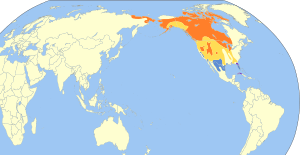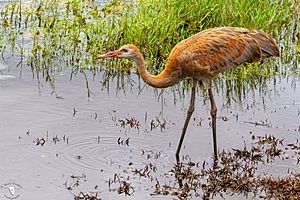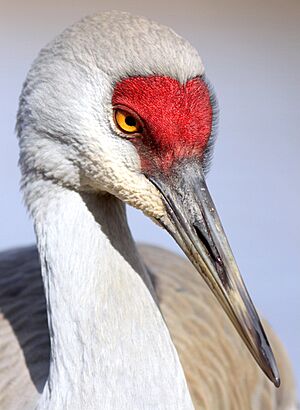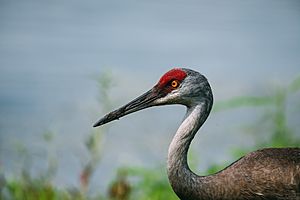Sandhill crane facts for kids
Quick facts for kids Sandhill crane |
|
|---|---|
 |
|
| Adult (behind) and juvenile | |
| Conservation status | |
| Scientific classification | |
| Genus: |
Antigone
|
| Species: |
canadensis
|
| Subspecies | |
|
|
 |
|
| Synonyms | |
|
|

The sandhill crane (Antigone canadensis) is a large species of crane found in North America and parts of northeastern Siberia. Its name comes from places like the Platte River in Nebraska, which is near the Sandhills. This area is a very important stop for many sandhill cranes during their yearly migration. Up to 450,000 of these birds, especially the lesser sandhill crane, pass through here every year.
Scientists once placed the sandhill crane in the genus Grus. However, a study in 2010 showed that this group of birds needed to be reorganized. Because of this, the sandhill crane and three other species were moved to a different genus called Antigone. This genus was first named by a German naturalist in 1853. The word canadensis in its scientific name means "Canadian" in modern Latin.
Contents
What Does a Sandhill Crane Look Like?
Adult sandhill cranes are mostly gray. When they are breeding, their feathers can look worn and stained, often appearing nearly yellowish-brown. This is especially true for the cranes that migrate long distances.
Males are usually heavier, weighing about 4.57 kilograms (10 pounds). Females weigh around 4.02 kilograms (8.8 pounds). Their weight can range from 2.7 to 6.7 kilograms (6 to 14.7 pounds) depending on the type of sandhill crane.
Sandhill cranes have red foreheads and white cheeks. They have long, dark, pointed bills. When they fly, their long, dark legs stretch out behind them. Their long necks stay straight. Young cranes have reddish-brown feathers on their backs and gray feathers on their undersides. Both male and female cranes look similar.
The size of these birds changes between the different types, or subspecies. On average, they stand about 80 to 136 centimeters (31 to 54 inches) tall. Their wingspan is typically 1.65 to 2.30 meters (5.4 to 7.5 feet). This large wingspan helps them fly very well.
Crane Calls and Flight
Sandhill cranes often make a loud, trumpeting call. It sounds like a rolled "r" from deep in their throat. You can hear their calls from far away. Mated pairs do a special "unison calling" where they stand close and call together. The female calls twice for every one call from the male.
With their large wings, sandhill cranes are excellent soaring birds. They fly much like hawks and eagles. They use warm air currents called thermals to lift themselves high. This allows them to stay in the air for many hours. They only need to flap their wings sometimes, which saves a lot of energy.
When migratory flocks fly, they can have hundreds of birds. These large groups can even show the outlines of the invisible thermals they are riding. Sandhill cranes fly south for the winter. In their winter homes, they gather in huge flocks of over 10,000 birds. One famous place for this is Bosque del Apache National Wildlife Refuge in New Mexico. An annual festival is held there in November to celebrate the cranes.
Sandhill Crane Behavior and Life Cycle
Sandhill cranes are social birds. They usually live in pairs or family groups throughout the year. During migration and winter, different crane families join together. They form "survival groups" to find food and rest together. These groups can become very large, sometimes thousands of birds.
What Do Sandhill Cranes Eat?
Sandhill cranes mostly eat plants, but they also eat other things depending on what is available. They often use their bills to dig in the ground for seeds and other foods. They look for food in shallow wetlands or dry land areas with plants.
Cranes like to eat farm crops such as corn, wheat, and sorghum. Leftover corn from farms is very helpful for cranes getting ready for migration. It gives them the energy they need for their long journey. Cranes in northern areas have a more varied diet, especially when they are breeding. They eat berries, small mammals, insects, snails, reptiles, and amphibians.
Reproduction and Raising Young
Sandhill cranes have one group of chicks each year. In areas where they don't migrate, they start laying eggs between December and August. For cranes that migrate, egg-laying usually begins in April or May.
Both parents work together to build the nest. They use plant materials from around the area. Nests are usually in marshes, bogs, or wet grassy areas. Sometimes, they build nests on dry land. Females lay one to three eggs, but usually two. The eggs are oval, dull brown, and have reddish marks. Both parents sit on the eggs for about 30 days until they hatch.
The chicks are born ready to go! They are covered in soft down feathers, their eyes are open, and they can leave the nest within a day. The parents keep the chicks warm for up to three weeks after they hatch. They feed them a lot for the first few weeks. Then, they feed them less often until the chicks can take care of themselves at 9 to 10 months old.
The young cranes stay with their parents for 10 to 12 months. They leave their parents about one or two months before the parents lay new eggs the next year. After leaving their parents, the young cranes join groups with other young birds and non-breeding adults. They stay in these groups until they find a mate and start breeding, which happens when they are between two and seven years old.
Who Hunts Sandhill Cranes?
Sandhill cranes live on the ground, so they can be hunted by other animals. Predators are the main natural cause of death for cranes. Mammals like foxes, raccoons, coyotes, wolves, cougars, bobcats, and lynx will hunt them. Foxes, raccoons, and coyotes mostly hunt young cranes. The other larger predators more rarely catch full-grown cranes.
Birds like ravens and crows, gulls, and smaller hawks (like northern harriers or red-tailed hawks) eat young cranes and their eggs. Both types of eagles in North America hunt cranes of all ages. Great horned owls and even the smaller peregrine falcons might also hunt young cranes or even adults. In some areas, golden eagles and bobcats are the biggest threats to older young cranes and adults. Coyotes, ravens, raccoons, and American mink are the main predators for chicks. In places like Cuba and Florida, American crocodiles and alligators can also catch many sandhill cranes, especially young ones.
Sandhill cranes defend themselves and their young from birds flying overhead by jumping and kicking. Parents protecting their chicks are more aggressive towards predators. Cranes that are not breeding usually try to run or fly away from attacks. For predators on the ground, cranes will move forward, often hissing. They spread their wings and point their bills. If the predator keeps coming, the crane will stab with its bill. Their bill is strong enough to pierce the skull of a small animal. They also kick.
Protecting Sandhill Cranes
In the 1930s, sandhill cranes almost disappeared from areas east of the Mississippi River. But their numbers have grown back. In 2018, there were an estimated 98,000 cranes in that region, which was a big increase.
While sandhill cranes as a whole are not considered endangered, the three types that live furthest south are quite rare. These cranes do not migrate, so they cannot choose safer places to breed. Many groups of cranes were lost due to hunting or changes in their habitat. The greater sandhill crane was hit the hardest. By 1940, fewer than 1,000 of these birds were left. However, their numbers have greatly increased since then. Even at nearly 100,000, they are still fewer than the lesser sandhill crane. The lesser sandhill crane is the most common crane, with about 400,000 birds across the continent.
Some groups of migratory sandhill cranes face problems because of competition with snow geese. Since the 1990s, snow geese have eaten the leftover corn that cranes also need before they migrate. Hunting also threatens sandhill crane populations. Hunting cranes is allowed in many states in the central part of the United States. However, it is illegal in Nebraska.
Even with hunting, competition, and habitat loss, the sandhill crane has spread to new areas. Since the early 2000s, they have expanded their winter and breeding grounds further north, even into upstate New York. In the 21st century, parts of the Midwestern United States have seen a big comeback for the species.
Moving wild birds and releasing birds raised in captivity into areas with few cranes has been a successful way to help them.


The Mississippi sandhill crane has lost the most of its original living area. It used to live along most of the northern Gulf of Mexico coast. As of 2013, only about 25 breeding pairs exist. These birds are carefully managed. The Mississippi Sandhill Crane National Wildlife Refuge was created in 1975 when there were fewer than 35 of these birds left. This refuge has the largest crane release program in the world. About 90% of the cranes there were raised in captivity.
Sometimes, the second egg from a two-egg nest was taken starting in 1965. These eggs were used to start a group of cranes that live in captivity. This breeding group is split between the Audubon Institute's Species Survival Center and White Oak Conservation in Yulee, Florida. These cranes have produced young birds that are released into the refuge every year.
A Mississippi sandhill crane was the first bird to hatch from an egg fertilized by sperm that had been frozen. This happened at the Audubon Nature Institute, as part of the plan to help this endangered type of crane recover.
About 300 Cuban sandhill cranes exist. This group is the least known. In January 2019, about 25,000 to 30,000 cranes were found spending the winter at the Whitewater Draw State Wildlife Area in Arizona.
Sandhill cranes were once used to help raise whooping cranes in plans to bring them back. However, this did not work well. The whooping cranes learned to act like their sandhill crane foster parents. Later, they did not recognize other whooping cranes as their own kind. They tried to find mates among the sandhill cranes instead, which was not successful.
Where Else Do Sandhill Cranes Go?
Sometimes, sandhill cranes show up in Europe as vagrants. This means they have wandered far from their usual homes. The first time one was seen in Britain was in April 1981. Small groups have also been seen in parts of eastern China and Taiwan. In 2022, people started reporting regular sightings of sandhill cranes in New Brunswick, on the Atlantic coast of Canada.
Images for kids
-
Sandhill crane in flight at the Llano Seco Unit of the Sacramento National Wildlife Refuge Complex in January 2022
See also
 In Spanish: Grulla canadiense para niños
In Spanish: Grulla canadiense para niños










